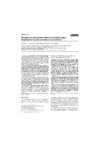Identificador persistente para citar o vincular este elemento:
https://accedacris.ulpgc.es/jspui/handle/10553/76756
| Campo DC | Valor | idioma |
|---|---|---|
| dc.contributor.author | Benito Peinado, Pedro José | en_US |
| dc.contributor.author | Calderón, F. J. | en_US |
| dc.contributor.author | García-Zapico, Augusto | en_US |
| dc.contributor.author | Legido, J. C. | en_US |
| dc.contributor.author | Caballero, J. A. | en_US |
| dc.date.accessioned | 2020-12-17T08:26:20Z | - |
| dc.date.available | 2020-12-17T08:26:20Z | - |
| dc.date.issued | 2006 | en_US |
| dc.identifier.issn | 0300-2896 | en_US |
| dc.identifier.other | Scopus | - |
| dc.identifier.uri | https://accedacris.ulpgc.es/handle/10553/76756 | - |
| dc.description.abstract | OBJECTIVE: There is some debate about the participation of the Hering-Breuer reflex during exercise in human beings. This study aimed to investigate breathing pattern response during an incremental exercise test with a cycle ergometer. Participation of the Hering-Breuer reflex in the control of breathing was to be indirectly investigated by analyzing the ratio of tidal volume (VT) to inspiratory time (tI). SUBJECTS AND METHODS: The 9 active subjects who participated the study followed an incremental protocol on a cycle ergometer until peak criteria were reached. During exercise, VT/ti can be described in 2 phases, separated by activation of the Hering-Breuer reflex (inspiratory off-switch threshold). In phase 1, ventilation increases because VT increases, resulting in a slight decrease in tI, whereas, in phase 2, increased ventilation is due to both an increase in VT and a decrease m t I. RESULTS: The mean (SD) inspiratory off-switch threshold was 84.6% (6.3%) when expressed relative to peak VT (mean, 3065 [566.8] mL) and 48% (7.2%) relative to the forced vital capacity measured by resting spirometry. The inspiratory off-switch threshold correlated positively (r=0.93) with the second ventilatory threshold, or respiratory compensation point. CONCLUSIONS: The inspiratory off-switch threshold and VT/t i are directly related to one another. The inspiratory off-switch threshold was related to the second ventilatory threshold, suggesting that the Hering-Breuer reflex participates in control of the breathing pattern during exercise. Activation of the reflex could contribute by signaling the respiratory centers to change the breathing pattern. | en_US |
| dc.description.abstract | La participación del reflejo de Hering-Breuer durante el ejercicio en seres humanos es objeto de discusión. El propósito del presente trabajo ha sido estudiar la respuesta del patrón respiratorio durante un esfuerzo incremental en cicloergómetro para comprobar, de forma indirecta, mediante el análisis de la relación volumen corriente-tiempo inspiratorio (VT/tI), la participación del reflejo de Hering-Breuer en el control de la respiración.Sujetos y métodos: Han participado en el estudio 9 sujetos activos que han llevado a cabo un protocolo incremental en cicloergómetro hasta alcanzar criterios máximos. Se ha comprobado que la relación VT/tI durante el ejercicio presenta 2 fases con un punto de ruptura, denominado punto de ruptura Hering-Breuer (PHB): fase I, donde el incremento de la ventilación se produce a expensas del aumento del VT con ligero descenso del tI, y fase II, durante la cual el incremento ventilatorio se produce tanto por el aumento del VT como por el descenso del tI. Resultados: En el estudio, el PHB se alcanzaba a un valor medio (± desviación estándar) del 84,6 ± 6,3% respecto al máximo valor de VT (3.065 ± 566,8 ml) y de un 48 ± 7,2% respecto al valor de la capacidad vital forzada medida en la espirometría de reposo. El PHB se relacionó de forma positiva (r = 0,93) con el umbral ventilatorio 2 o umbral de compensación respiratoria. Conclusiones: Existe relación directa entre el PHB y VT/tI. El PHB se relaciona con el umbral ventilatorio 2, de manera que intervendría en el control del patrón ventilatorio durante el ejercicio. La entrada en funcionamiento del reflejo podría contribuir informando a los centros respiratorios para llevar a cabo el cambio de patrón ventilatorio. | en_US |
| dc.language | spa | en_US |
| dc.relation.ispartof | Archivos de Bronconeumologia | en_US |
| dc.source | Archivos de Bronconeumologia [ISSN 0300-2896], v. 42 (2), p. 62-67, 2006 | en_US |
| dc.subject | 241106 Fisiología del ejercicio | en_US |
| dc.subject.other | Breathing Pattern | en_US |
| dc.subject.other | Hering-Breuer Reflex | en_US |
| dc.subject.other | Ventilatory Threshold | en_US |
| dc.subject.other | Patrón respiratorio | en_US |
| dc.subject.other | Reflejo de Hering-Breuer | en_US |
| dc.subject.other | Umbral ventilatorio | en_US |
| dc.title | Respuesta de la relación volumen corriente-tiempo inspiratorio durante un esfuerzo incremental | en_US |
| dc.title.alternative | Response of tidal volume to inspiratory time ratio during incremental exercise | en_US |
| dc.type | info:eu-repo/semantics/Article | en_US |
| dc.type | Article | en_US |
| dc.identifier.doi | 10.1157/13084396 | en_US |
| dc.identifier.scopus | 33644846981 | - |
| dc.contributor.authorscopusid | 36748282700 | - |
| dc.contributor.authorscopusid | 35723587100 | - |
| dc.contributor.authorscopusid | 12773665900 | - |
| dc.contributor.authorscopusid | 7005076586 | - |
| dc.contributor.authorscopusid | 57215515291 | - |
| dc.description.lastpage | 67 | en_US |
| dc.identifier.issue | 2 | - |
| dc.description.firstpage | 62 | en_US |
| dc.relation.volume | 42 | en_US |
| dc.investigacion | Ciencias de la Salud | en_US |
| dc.type2 | Artículo | en_US |
| dc.utils.revision | Sí | en_US |
| dc.date.coverdate | Enero 2006 | en_US |
| dc.identifier.ulpgc | Sí | en_US |
| dc.description.jcr | 1,851 | |
| dc.description.jcrq | Q3 | |
| dc.description.scie | SCIE | |
| item.grantfulltext | open | - |
| item.fulltext | Con texto completo | - |
| Colección: | Artículos | |
Citas SCOPUSTM
10
actualizado el 08-jun-2025
Citas de WEB OF SCIENCETM
Citations
7
actualizado el 08-jun-2025
Visitas
121
actualizado el 31-may-2025
Descargas
544
actualizado el 31-may-2025
Google ScholarTM
Verifica
Altmetric
Comparte
Exporta metadatos
Los elementos en ULPGC accedaCRIS están protegidos por derechos de autor con todos los derechos reservados, a menos que se indique lo contrario.
